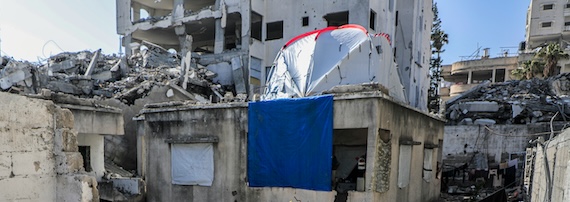In the past two years, Israeli obliteration has turned Gaza into an uninhabitable death zone. What is less known, however, is that this is the effect of decades of deliberate ecocide – and of the West’s purposeful efforts to undermine both genocide and ecocide legislation.
New York (Special to Informed Comment; Feature) – The final step of the broadest possible genocide is ecocide; that is, the intentional destruction of the environment necessary for the support of human life.
Ecocide, in turn, is directly related to the decimation of the reproduction of culture that Raphael Lemkin, the pioneer of the Genocide Convention, associated with the concept of “cultural genocide.”
Gaza is a textbook case.
The long legal effort to suppress ecocide
In The Obliteration Doctrine, I show in painful detail how Lemkin had to compromise this idea. While he got strong support from the countries of the Global South, the former colonial powers, led by the United States and the United Kingdom, undermined Lemkin’s quest. Consequently, the current Genocide Convention is just a mutilated torso of the original idea.
Ever since Olof Palme, the Swedish prime minister, accused the United States of ecocide at the 1972 UN Conference on the Human Environment, war has often seen as the primary cause of ecocide, along with over-exploitation of natural resources and industrial disasters.
In environmental law, ecocide (from ancient Greek oikos ‘home’ and Latin caedere ‘to kill’) connotes the destruction of the environment by humans. It has often been associated with genocide. In effect, in the late 1990s ecocide in peacetime was to have been included in the Rome Statute. However, it was deleted due to objections by the United Kingdom, France, and the United States; that is, by the former colonial powers. Such censure would not have surprised Lemkin who knew well that these powers did not want to pay for their crimes in the world court. Nonetheless, as a result, the Rome Statute of the International Criminal Court makes no provision for the crime of ecocide in peacetime, only in wartime.

Or by check:
Juan Cole
P. O. Box 4218,
Ann Arbor, MI 48104-2548
USA
(Remember, make the checks out to “Juan Cole” or they can’t be cashed)
Just months before October 7, 2023, the Independent Expert Panel for the Legal Definition of Ecocide defined it as “unlawful or wanton acts committed with knowledge that there is a substantial likelihood of severe and either widespread or long-term damage to the environment being caused by those acts.”
The decades-long ecocide in Gaza
Well before October 7, 2023, the Gaza Strip had progressively been isolated from the West Bank and the outside world overall, while being subjected to repeated Israeli military incursions – over three decades, in parallel with the Madrid and Oslo peace talks.
In terms of environmental damage, deterioration had worsened since 2014, when the clearing and bulldozing of agricultural and residential lands by the Israeli military close to the eastern border of Gaza had been coupled with the unannounced aerial spraying of crop-killing herbicides. These illicit practices not only destroyed entire swaths of formerly arable land along the border fence but also crops and farmlands hundreds of meters deep into Palestinian territory, resulting in the loss of livelihoods for Gazan farmers.
In a historical view, such massive bombardment went back to the early days of the Cold War, when the United States dropped bombs on North Korean dams to flood crops and induce starvation among civilians. To compound the same effect, irrigation systems were attacked on the ground. The difference is that in Gaza the geographic scope of destruction was far narrower than in Korea, but the decimation far more effective, intensive and lethal.
Colonial violence and environmental warfare
From the beginning, “environmental warfare in Gaza” has been marked by colonial violence. It has been an inherent part of the Palestinian expulsions and Israeli occupation since the late 1940s.
Furthermore, the destruction is central to the Obliteration Doctrine of the Israeli military, which was initiated in Lebanon in the late 2000s and perfected in Gaza in 2023-25. In that sense, the Nakba has also a lesser-known environmental dimension, “the complete transformation of the environment, the weather, the soil, the loss of the indigenous climate, the vegetation, the skies. The Nakba is a process of colonially imposed vulnerability to climate change.”
Even at the eve of October 7, World Bank analysts warned that in the West Bank and Gaza, drivers of fragility, development constraints, and vulnerability to climate change were closely interconnected, thanks to decades of the fragmentation of land, restrictions on the movement of people and goods, recurrent episodes of violent conflict, persistent political and policy uncertainty, and the lack of sovereign control over critical natural resources.
As the net effect of the Gaza War, widespread damages to built-up areas from the use of explosive weapons have resulted in direct impacts on water services and in millions of tons of debris, toxic waste and destroyed agricultural lands. This has led to the outbreak of communicable diseases from poor water, health and sanitation conditions, combined with the risk of exposure to a range of additional hazardous materials and the collapse of environmental governance.
Never miss an issue of Informed Comment: Click here to subscribe to our email newsletter! Social media will pretend to let you subscribe but then use algorithms to suppress the postings and show you their ads instead. And please, if you see an essay you like, paste it into an email and share with friends.
The death zone
Hence, the damage to water infrastructure and widescale urban destruction in combination with a severely degraded healthcare system; all of which posed a long-lasting threat to both public health and livelihoods.
The future that awaited Palestinians at the end of the hostilities was a Gaza turned into an “uninhabitable death war zone.”
By late April 2024, Israel’s obliteration of Gaza had already created 37m tonnes of debris. That amounts to an average of 300kg of rubble per square meter of land in the Gaza Strip. Worse, much of these piles and heaps of debris and wreckage were laced with unexploded bombs, which could take up to 15 years of extensive work to remove, assuming the availability of 100 trucks on a daily basis.
Taking into consideration the fact that on average about 10 percent of weapons failed to detonate when fired, huge demining teams would be warranted for years. The longer the war continued, the longer would the clearance take at its end.
During the first two months of Israel’s assault on Gaza, the projected emissions from there exceeded the annual emissions of 20 individual countries and territories.
Indeed, the total emissions increased to more than those of over 33 individual countries and territories when the war infrastructure built by both Israel and Hamas is included, such as Hamas’s tunnel network and Israel’s protective fence or “Iron Wall.” In that light, the carbon costs of reconstructing Gaza are likely to prove huge.
The rebuilding emissions ahead
Effectively, rebuilding Gaza will result in a total annual emissions figure higher than that of over 130 countries, putting them on a par with that of New Zealand.
The overwhelming majority of the 281,000 metric tons (MT) of carbon dioxide (CO2) generated in the first two months of hostilities can be traced to Israel’s aerial bombardment and ground invasion of Gaza.
Almost half the total carbon emissions were down to U.S. cargo planes flying military supplies to Israel. By contrast, Hamas rockets fired into Israel in the same period generated 713 MT of CO2, which is equivalent to 300 MT of coal. There was no symmetry in war machinery.
The initial brutal offensive by Hamas was overwhelmed by Israel’s obliteration of what used to be Gaza. Worse, these estimates are highly conservative because they are based on just two months of the war that had already endured three times longer by June 2024.
More importantly, the actual carbon footprint could prove five to eight times higher, when emissions from the entire war supply chain were included.
Furthermore, what has happened in Gaza won’t stay in Gaza. Even the perpetrators cannot avoid their own poison.

File photo of Gaza, Feb. 18, 2025, by Mohammed Ibrahim on Unsplash
Spillovers of ecocide
The overall cost for rebuilding Gaza is estimated to be tens of billions of dollars over decades, with some projections reaching as high as $70 billion.
The obliteration of Gaza has inflicted severe and potentially irreversible environmental damage, including widespread contamination of water, soil, and air with toxic substances, the collapse of critical infrastructure, and massive carbon emissions.
The effects of this environmental catastrophe are likely to mimic those of past conflicts involving widespread environmental destruction – for instance, U.S. deployment of Agent Orange in Vietnam – which in one form or another will likely be felt by Israeli citizens for years or decades to come.
In the foreseeable future, these key impacts on Israel may include public health crises, water contamination, adverse agricultural and economic effects, rising contribution into climate change, not to mention the security concerns that will ensue from the deliberate creation of an uninhabitable environment in Gaza.
As Israeli environmental groups warned already a decade ago, the untreated sewage from Gaza that has flowed into the Mediterranean Sea is a ticking time bomb. Following the obliteration of Gaza, the destruction of wastewater treatment facilities creates a significant risk of infectious diseases, even cholera, that could spread along the coast. Additionally, the potential contamination of shared coastal aquifers with seawater, heavy metals, and chemicals poses a long-term threat to Israel’s freshwater supplies.
The inconvenient truth is that water contamination, like ecocide, knows no borders.


 © 2025 All Rights Reserved
© 2025 All Rights Reserved